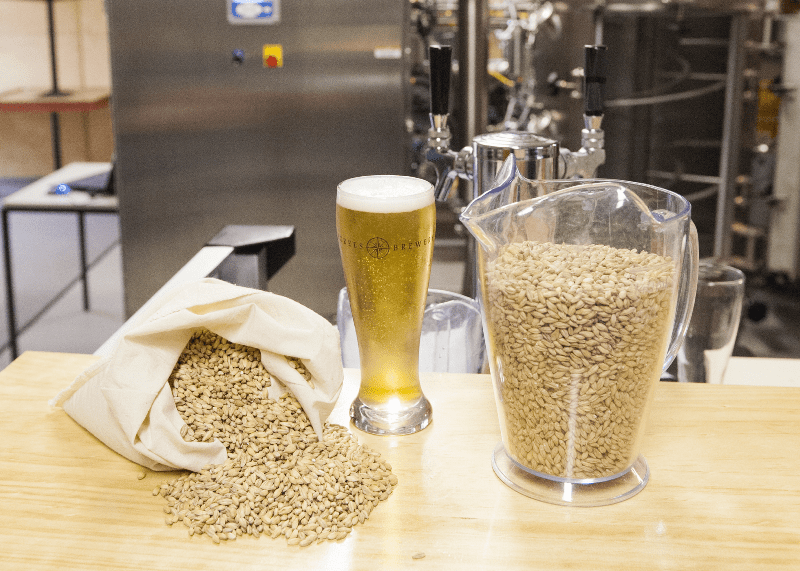
A bus in China advertises Yanjing, one of the country’s most popular beers.
A CHANGING beer market and China’s imposition of tariffs on Australian barley are exerting their might on global barley values, which appear to be holding up despite more bearish than bullish factors.
On the demand side, COVID-19 closures around the world have killed demand for draught beer at a time when global demand for the amber fluid was trending away from industrial beer to craft brews.
Post COVID, the Asian beer market appears to be leading the world in regaining its appetite for beer.
Vital signs improving
The slowdown in malting and brewing caused by COVID-19 has clogged up the global supply chain from malthouse intake to packaged beer point-of-sale.
Starting in China, the slowdown spread throughout Asia and the Pacific, and then to Europe and now the Americas to track the spread of the pandemic.
Malteurop Australia/New Zealand managing director Trevor Perryman said Asian malting markets were showing stronger vital signs than Australia as countries slowly emerge from COVID-19 lockdown.
Malteurop’s one Australian plant at Geelong in Victoria expanded in 2018, and now has the capacity to malt 200,000 tonnes of barley per annum, up from 80,000t previously, making it Australia’s largest malthouse.
Malteurop Geelong has been exporting up to 90 per cent of its malt to mostly Asian countries excluding China, which makes for beer production its own malt in vast quantities from imported and domestic barley.
“We’ve been impacted by COVID-19,” Mr Perryman said.
“The supply chains have become quite full, and as economies open up, it will relieve congestion.
“There’s a pulse in Asia now.
“In Australia, there’s a pulse here, but it’s not a strong one.”
Mr Perryman said domestic brewing had a “sugar hit” when grocery demand surged as Australia went into COVID-19 lockdown.
He said the upswing was short-lived, and offset by the hiatus in draught beer sales, which account for 30pc of the Australian market.
Choices for China
When the China-Australia Free Trade Agreement signed in 2015 came into force, Chinese tariffs of 10pc on Australian malt and 3pc on Australian malting and feed barley were scrapped.
For a time ChAFTA gave Australia preferential treatment compared with other origins exporting barley to China.
“In terms of opportunity into China, could we as Australian maltsters export our malt to China?
“The answer to that is ‘possibly’.
“Under current FTA agreements, there shouldn’t be any reason why that doesn’t have potential.
“Will the Chinese brewers switch to buying malt? That will be price dependent.”
Sources have told Grain Central that Australia has a significant freight advantage over Europe when it comes to shipping malt into South-East Asia.
For now, China is dealing with the last cargoes of Australian barley it is likely to see for some time.
Grain Central understands that of the four Australian barley cargoes loading for China or on their way when the tariffs were announced on 18 May, one may have discharged, two are in Chinese waters, and one is not far away.
Possible exemptions
Mr Perryman said without exemptions to import Australian barley to malt for re-export, China could be less of a competitor against Australia in Asian malt markets.
“China does sell malt into South-East Asia, but if their incoming malting barley price goes up, they’ll be less competitive.”
Exemptions for malting barley imported from Australia to produce malt for China to re-export may be a workable solution for Chinese importers with cargoes booked.
The practice of tariff relief, known as the inward processing regime, was adopted successfully by Turkey to drive wheat imports and flour exports.
Whichever way China goes, Grain Central understands maltsters in Australia are yet to hear from China to buy Australian-processed malt.
“We’re not getting inquiry.”
Unless Chinese importers can gain exemptions, several Australian cargoes exporters hoped to load for China over coming months will have to be resold to other markets if importers choose to “wash out” contracts.
But for business booked but not yet shipped, and unless Chinese importers can gain exemptions, several Australian cargoes will have to be resold to other markets if parties were to choose to wash out contracts.
The cost to Chinese counterparties of wash-outs will be much cheaper than paying tariffs.
Competitor stakes
China appears to be busy crunching the numbers on booking more new-crop French and Canadian barley to fill the Aussie void.
China imports around 3.5 million tonnes (Mt) of barley per annum, with roughly 2.5Mt coming from Australia.
Ballpark figures for the remaining 1Mt typically were split roughly three-quarters Canadian premium-priced malting barley and one-quarter French. Both origins seem set to surge in market share this year.
New-crop French barley will be available for shipment from July, and Canada’s crop typically comes to market in September.
International markets saw activity in Europe ramp up this week, in particular traders reported single variety two-row French malting French malting barley bookings on rising prices into China for shipment over the coming quarter at premiums around US$30/t over feed.
It is normal for this time of year for European origin activity to ramp up, and Canada’s premium malting sales will engage when crops there are safely in the bin.
Australia this year had a modest crop to ship because drought decimated 2019 production in New South Wales.
Chinese buyers and Australian exporters saw this, and the likelihood of Chinese tariffs being imposed, as reason to fast-track shipment of Australian malting barley.
“Because of the threat of tariffs, most have front-ended that activity,” a trader said.
Between 1 December and 31 March, Australia’s barley shipments to China totalled 563,640t of malting and 64,500t of feed, almost half the 1.3Mt in total of Australian barley shipped during the period.

Australian research and marketing programs have sought to secure Australian barley a premium place in the Asian malting market. Photo: DAFWA
Hopes for early end
The tariffs imposed by China on Australian barley are set to be in place until May 2025, but Rabobank senior grains analyst Dr Cheryl Kalisch Gordon said China might come back to Australia by next year.
“While I think China can go without Australia’s feed barley (it needs less and can source substitutes elsewhere), at some stage during 2020/21 they can be expected to come back to Australia for malting barley.
“It will certainly be less than we have been exporting to them, both due to their lower year-on-year beer consumption, and because they will source malting barley elsewhere.
“With malt being less substitutable, China should need to come back to the market at some point.”
This could be via reshuffled supply chains as some of Australia’s competitors shift more product into China and are less able to put usual volumes into their regular markets.
“There will be a movement of deckchairs so that we can look to other markets; however, this won’t happen overnight, and other market opportunities do not represent the same scale of opportunity.”
Export avenues for barley
Following a whack of business done when the Australian dollar dived in March to multi-year lows, Australian farmers have little 2019 crop barley to sell, and exporters would struggle to put together another cargo beyond those previously booked for China.
Grain Central understands one feed barley cargo loaded for China has now been diverted to the United Arab Emirates (UAE), and Middle East feed markets will absorb some of the malting tonnage China is now highly unlikely to take.
Destinations are likely to be Saudi Arabia and the UAE, both long-term buyers of Australian feed barley, and Thailand as the biggest emerging market.
Japan is a long-time feed, food and malting barley customer. Ongoing, stable trade between Japan and Australia is a backbone of premium, long-term and respectful business between customer and supplier.
Vietnam as a developing malting market, is shortlisted to take additional cargoes in the back end of Australia’s shipping year.
“We do need, quite urgently, to look at new markets,” GrainGrowers chairman Brett Hosking said.
“We have become very reliant on China, but if you had to rewrite history, we’d do it all again.”
Domestic option
The Queensland drought market looks like it could continue into next year, with little wheat and barley planted and time running out to get a big crop in the ground at the ideal time.
While much of New South Wales is now pulling out of drought, districts in southern and central Queensland are still in full or partial drought, with the Queensland sorghum crop now being harvested doing little to alleviate the state’s feedgrain deficit now in its third year.
This means Queensland feedlots, stockfeed mills and piggeries could be in the market for interstate barley for up to 18 months.
Grain Central: Get our free daily cropping news straight to your inbox – Click here



HAVE YOUR SAY